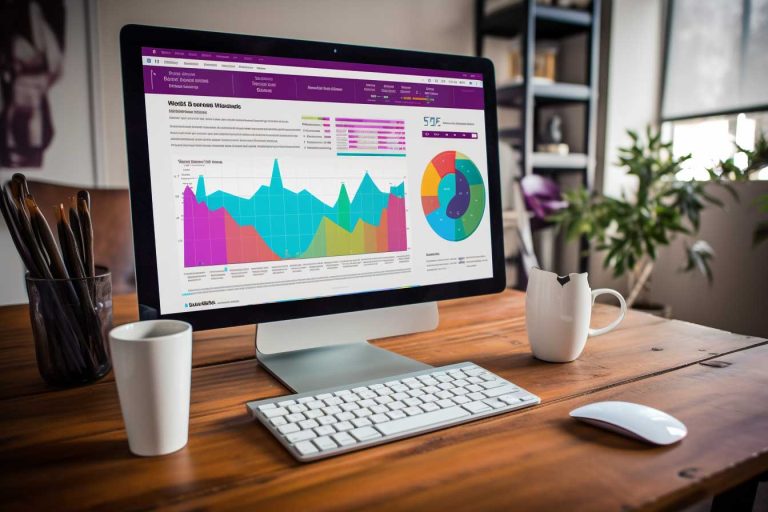Harnessing the Power of Influencer Marketing for Small Businesses
Did you know that 69% of consumers trust what influencers say? Welcome to influencer marketing’s exciting world. In 2023, businesses spent a whopping $6.16 billion on influencer marketing. This shows the big chance for growth in digital marketing.
For small businesses, working with influencers is a big deal. It’s like finding a hidden treasure. By teaming up with popular figures in various areas, brands can reach their ideal customers more easily. This partnership boosts brand visibility and builds trustworthy relationships with potential buyers.
Imagine tapping into communities that already love and trust certain influencers. Collaborating with these influencers can skyrocket a brand’s recognition and keep customers coming back. Plus, diving into the detailed data from these influencers gives companies valuable tips. This helps them tweak their marketing plans to better appeal to their audience.
So, why wait? Jumping into influencer marketing can carve out a unique story for your brand. It draws in both new and old customers, pushing your digital marketing to new heights.
Key Takeaways
- 69% of consumers trust influencer recommendations.
- Spending on influencers hit $6.16 billion in 2023.
- Influencer partnerships strengthen brand recognition and trust.
- Studying influencer data improves marketing strategies.
- Influencer marketing creates real links with target markets.
Understanding Influencer Marketing for Small Businesses
Small businesses need to understand influencer marketing to make a mark online. It’s about using influencers to promote your brand. These influencers have lots of followers and can help increase your brand’s awareness and trust.
Definition and Importance
Influencer marketing means working with popular individuals to reach potential customers. These influencers have strong bonds with their followers, making your brand seem more trustworthy. With costs for collaborations starting from $250 for every 10K followers, it’s vital to have clear goals. This approach has been proven to significantly improve sales, lead generation, and brand visibility for small businesses.
Types of Influencers
Influencers can be of various types, each benefiting your business differently.
- Micro-influencers: They have 1,000 to 100,000 followers and highly engaged communities. Their recommendations appear more authentic, perfect for brands valuing genuineness.
- Nano-influencers: They have fewer than 1,000 followers but are extremely loyal, great for targeting specific niches.
- Macro-influencers: These influencers have vast followings, offering wide exposure.
- Celebrity influencers: Known globally, they provide immense visibility, though they’re more pricey.
Knowing these types helps businesses match their marketing strategies with their objectives and budget.
Growing Trends in Influencer Marketing
The influencer marketing world is evolving, focusing more on authenticity and long-lasting partnerships. People now prefer stories that feel real, not just polished ads. This builds trust and strengthens brand credibility.
Using tools like Later Influence simplifies finding and collaborating with the right influencers. It helps brands quickly find influencers who match their style and goals, making campaigns more effective.
More businesses are weaving influencer marketing into their digital strategies. They recognize its power in driving sales and enhancing brand awareness. Building true partnerships with influencers is key. It goes beyond just paying them; it’s about mutual benefits.
In conclusion, getting the hang of influencer marketing can guide small businesses. It helps them use endorsements from niche influencers effectively. This boosts their brand and ensures success in digital marketing.
Benefits of Influencer Marketing
Influencer marketing has become a powerful tool for small businesses. It helps build strong relationships with influencers, boosting visibility and credibility. This approach reaches targeted audiences effectively.
Enhanced Brand Awareness
Influencers can dramatically increase brand awareness. They help businesses tap into niche markets. For example, Athletic Greens’ TikTok campaign reached over 90.6 million views with its hashtags. Influencer marketing connects businesses with the right audience, making it a valuable tool.
Building Credibility and Trust
An influencer’s endorsement boosts a brand’s credibility. About 71% of people trust influencers’ recommendations. Bulldog’s German campaign is a great example. It got 29.8 million impressions and increased sales by 5%-10%. This shows how much people trust influencers, leading to stronger brand loyalty.
Achieving High ROI
Influencer marketing offers an excellent return on investment (ROI). Businesses can make $4.87 for every $1 spent. This approach is 30% cheaper than traditional ads. Doe Lashes, for instance, made $2.6K daily. With 82% of leads being high-quality, it brings immediate revenue and future customer loyalty.
Identifying and Vetting the Right Influencers
Finding the right influencers is key to a successful marketing strategy. Start by knowing your target audience well. Consider their age, gender, interests, and how they behave. This helps make sure the influencer’s followers match well with your brand.

Understanding Your Target Audience
Knowing your audience is the foundation of any marketing plan. Look closely at details such as age, gender, and interests. This helps find influencers whose followers might love your brand. For example, a fashion brand aimed at millennials might work well with fashion influencers who are micro or nano and interact well with their audience.
Researching Potential Influencers
Start by thoroughly researching potential influencers across Instagram, YouTube, and TikTok. This helps you see beyond just their number of followers. Check their engagement metrics closely. High engagement rates show that they interact well with their followers. But lower rates might mean their followers are not that interested.
Evaluating Engagement and Authenticity
Checking for real engagement and authenticity is crucial. Use tools like Social Blade and Upfluence to see an influencer’s track record and who their audience is. True engagement comes through real likes, comments, and shares. Avoid influencers who might have falsely increased their followers. This can harm your campaign’s trust.
In the end, choosing influencers carefully, who truly engage with their audience, can greatly help your brand. By taking the time to ensure the influencer fits well with your brand, you will see better results from your influencer marketing efforts.
Creating Effective Campaign Strategies
In the changing world of influencer marketing, making good campaign tactics is key. Success comes from setting clear goals that match the brand’s goals. This helps guide every part of your campaign.
Setting Clear Goals and Objectives
Starting with clear targets guides everything you do in your campaign. These can be to boost brand awareness, drive sales, or get more people to your website. These aims need to be clear to track progress properly.
With influencer marketing growing to $21.1 billion in 2023, setting goals is more important than ever. It can lead to direct increases in profits or more people engaging with your content.
Developing Engaging Content
Creating content that grabs attention is vital. It must truly reflect what your brand stands for. Engaging content is key, with studies showing it brings much higher interaction rates, especially with smaller influencers.
This engaging material, often made with influencers, boosts your campaign’s impact.
Collaborating with Influencers
Working with influencers is at the heart of a great campaign. These partnerships need honesty and respect to work well. This way, real, impactful content can be produced.
As many as 83% of marketers believe in influencer marketing’s effectiveness. It shows the value of picking the right people to work with. Collaborating closely, you can make content that really speaks to your audience and enhances your campaign.
By focusing on clear goals, making engaging content, and working with influencers, brands can create impactful campaigns. These core values are crucial for success now and will continue to be in the future.
Legal Considerations in Influencer Marketing
Influencer marketing is booming, making it vital to grasp its legal aspects. This ensures smooth collaborations and safeguards everyone involved. We will explore the main legal points that shape this field.
Disclosure Regulations
Following disclosure rules is key in influencer marketing. The FTC requires influencers to state any brand relationships openly. This includes posts, links, or products given for review. Failing to do so could lead to fines up to $43,792 each time. Thus, influencers must be transparent, using tags like #ad or #sponsored with their followers.
Contractual Agreements
Having detailed contracts in influencer marketing outlines the work scope, payment, and who owns the content. Such an agreement sets clear expectations, timelines, and what must be delivered. This shields both brand and influencer. A well-written contract reduces misunderstandings and fosters a professional bond.
Intellectual Property Rights
Intellectual property rights cover the use of images, videos, music, and more in influencer marketing. Ignoring these laws can cause big problems, including financial losses. It’s particularly important for nano and micro influencers to know these rules well. Setting these rights in contracts helps avoid conflicts and keeps both parties’ work protected. Getting legal advice is wise to ensure everything is correct and maintains the brand’s image.
Measuring and Analysing Campaign Success
Understanding how well influencer marketing campaigns work is key to getting better results and planning for the future. I use KPI tracking, analytics tools, and regular optimisation. These methods help me make the most of our efforts.
Tracking Key Performance Indicators (KPIs)
Key Performance Indicators (KPIs) are important to check the success of influencer campaigns. There are different kinds of KPIs, such as visibility, engagement, community growth, and sales. They offer valuable insights.
For example, looking at reach, engagement rates, and mentions shows how aware people are of the brand. Sales can be measured with special URLs and promo codes.
Utilising Analytics Tools
For good KPI tracking, strong analytics tools are needed. Tools like Google Analytics and others help break down campaign data. They let me keep an eye on web visits, engagement, and other important KPIs. This gives a detailed picture of our influencer marketing performance.
Earned Media Value (EMV) is also very helpful. It shows the worth of reach and engagement. It compares this to the cost of achieving similar results through paid ads.
Optimising Future Campaigns
Getting deep insights from KPIs and tools makes it easier to improve future campaigns. Knowing what works well and what doesn’t is useful. Based on this information, I make necessary changes. This approach helps our campaigns to better meet our audience’s changing interests and behaviours.
This cycle of analysis, learning, and improvement is crucial. It keeps our influencer marketing strategies working well over time.
Conclusion
In this article, we’ve seen how influencer marketing has grown to become a key player in marketing. For small businesses, micro-influencers help make this tool accessible and affordable. They range from those with millions of followers to those with just a few thousand.
The success of an influencer campaign depends on choosing influencers who share the brand’s values, creating engaging content, and keeping relationships transparent and beneficial. It’s crucial to measure success with metrics like reach, engagement, and sales. A 2018 study found that 92% of people think influencer marketing works, and 86% are ready to set aside budgets for it.
Brands like Daniel Wellington show how powerful influencer partnerships can be. They gained 1 million Instagram followers in their campaign’s first year and now have over 4.6 million. H&M’s work with fashion blogger Julie Sarinana in 2017 also shows the big impact successful influencer partnerships can have on brand visibility, a goal for 37% of those asked.
Influencer marketing can hugely affect brand growth, especially for small businesses. By following legal rules, analyzing campaign results, and building real connections with influencers, businesses can find great success. This sets the stage for lasting growth.








